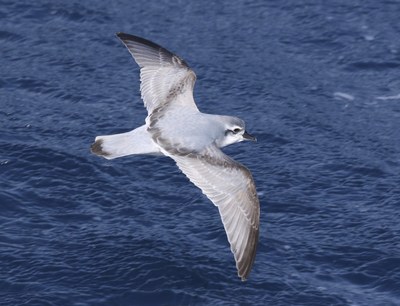How two species can become three
Salvin’s Prion, as a hybrid, is more efficient and successful than the original species
19 July 2019
Deutsche Fassung

The international team led by Prof. Quillfeldt showed that the two parent species produced a third species despite different feeding strategies and reproduction times. These hybrids have a new feeding strategy that is significantly more efficient than that of the parent species. In addition, they reproduce independently at other times of the year. The newly developed species live completely separated from their parent species and thus have the basic definition of a species: reproductive isolation.
In the Animal Kingdom, the so-called hybrid species development is an almost completely alien concept. To be able to reproduce, both parent species of the new species must have the same number of chromosomes. For example, a mule, the product of a horse and a donkey, which have a different number of chromosomes, is infertile. In contrast, the Salvin’s Prion is a comparatively successful hybrid - even more successful than the original species.
Petrels of the genus Pachyptila (prions) are a small group of closely related seabirds that have the same ancestors. They all look remarkably similar and differ mainly in the shape of their beaks. Dr. Masello and his team sequenced and analysed DNA from 425 individuals of five prion species and the closely related Blue Petrel (Halobaena caerulea). It turned out that the Salvin’s Prion was genetically grouped sometimes with one species, sometimes with the other. A hybrid origin could explain these unusual results.
"This study shows that hybridisation between species is not necessarily the end of the evolutionary line and that sometimes a new species can be formed in this way," explains Dr. Masello, who worked very closely with South African biologist Prof. Yoshan Moodley on the project.
- Publication:
Juan F. Masello, Petra Quillfeldt, Edson Sandoval-Castellanos, Rachael Alderman, Luciano Calderón, Yves Cherel, Theresa L. Cole, Richard J. Cuthbert, Manuel Marin, Melanie Massaro, Joan Navarro, Richard A. Phillips, Peter G. Ryan, Lara D. Shepherd, Cristián G. Suazo, Henri Weimerskirch, and Yoshan Moodley (2019). Additive Traits Lead to Feeding Advantage and Reproductive Isolation, Promoting Homoploid Hybrid Speciation, Molecular Biology and Evolution, msz090 | doi:10.1093/molbev/msz090
https://academic.oup.com/mbe/advance-article/doi/10.1093/molbev/msz090/5480301
- Contact
Dr. Juan F. Masello
Department of Animal Ecology & Systematics
Presse, Kommunikation und Marketing • Justus-Liebig-Universität Gießen • Telefon: 0641 99-12041
